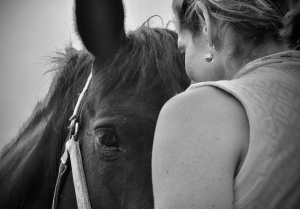Editor’s Note: Trish Lemke is the founder of Joy Rides. She leads horse riding excursions around the world and is a certified Martha Beck life coach. Lemke lives in Durango, Colorado, with her family and horses. She is part of Camp Cayuse, a program in development.
Lemke writes:
 I’m fascinated by how our brains work and why we do the things that we do. And I’m even more fascinated when the science and research can explain why the life-coaching tools and mindfulness exercises that I use work so well.
I’m fascinated by how our brains work and why we do the things that we do. And I’m even more fascinated when the science and research can explain why the life-coaching tools and mindfulness exercises that I use work so well.
Understanding the science helps us:
- Have more awareness of why we act and react to people, to situations, to life.
- Have more compassion for ourselves, especially when we think and do things we don’t like.
- Have more knowledge about how to change patterns and behaviors that may be harmful to us and to others.
- Work on simple tools to help make changes that bring about more happiness and peace.
Now who doesn’t want those things?
Even though the reasons may be simple, the brain science behind it all is a lot more complex, so I like to break it down into bite-sized concepts. Here’s one that I share today in hopes that it would give you some concrete things to do to help though a season of added stress and overwhelm.
It’s the concept of NIE’s or Neural Integrative Engagements. NIE is the idea of integrating gut, heart, and mind so that each is in an optimal state to send and receive messages from the other.
We can’t live in our minds alone. Nor can we just rely on intuition or act only with our heart. If our decisions are whole-body decisions, we will have far more success and less heartache.

Trish Lemke runs Joy Rides, life coaching and international horse trips
Some NIE’s to use are:
- Visualization and imagery
One really easy way to use this is to think about a really great memory. Play it back like it’s a movie. Remember who you were with, what the weather was like, what you were wearing, how you felt, etc. Now as you’re remembering, notice how your body is feeling.
Are you getting a bit lighter?
Is there a smile playing on your lips?
Does the memory bring about an expansion in your chest and deeper breathing?
With this exercise, you are integrating mind with body and allowing for greater and better communication.
- Sounds
Here’s another easy one to do: Put on a good song. Maybe one from your teenage years or one you loved as a kid. Something that connects you to a different place in your life when you felt carefree and good. Again, as you listen to that song or multiple songs, notice how your body is starting to feel.
Do you want to get up and dance?
Do you feel a bit less stressed?
Is it bringing a happiness to your heart?
Again, this is the process of integration of body and mind.
- Physical movement and touch
Yes, another easy one to do. Get up and move. Do a body scan to see what’s going on for you physically. Stretch, do some deep breathing, pet your dog, tense your muscles, and then relax them. All of these things help to bring about integration.
- Time in nature and with animals (no further explanations necessary!)
This is just a brief list with a few suggestions, but they will help to bring about more awareness, compassion, and connection if you practice them and keep being aware of the reasons why you’re doing them.
If you’re interested in this idea of brain science and why coaching and mindfulness techniques actually work, or if you’re interested in more guided help to you find your happiness and peace, let me know. I would love to share my learnings with you.
To learn more about the NIE concept, check out the book MBraining: Using your Multiple Brains to do Cool Stuff.